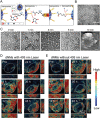Bioimaging guided pharmaceutical evaluations of nanomedicines for clinical translations
- PMID: 35590412
- PMCID: PMC9118863
- DOI: 10.1186/s12951-022-01451-4
Bioimaging guided pharmaceutical evaluations of nanomedicines for clinical translations
Abstract
Nanomedicines (NMs) have emerged as an efficient approach for developing novel treatment strategies against a variety of diseases. Over the past few decades, NM formulations have received great attention, and a large number of studies have been performed in this field. Despite this, only about 60 nano-formulations have received industrial acceptance and are currently available for clinical use. Their in vivo pharmaceutical behavior is considered one of the main challenges and hurdles for the effective clinical translation of NMs, because it is difficult to monitor the pharmaceutic fate of NMs in the biological environment using conventional pharmaceutical evaluations. In this context, non-invasive imaging modalities offer attractive solutions, providing the direct monitoring and quantification of the pharmacokinetic and pharmacodynamic behavior of labeled NMs in a real-time manner. Imaging evaluations have great potential for revealing the relationship between the physicochemical properties of NMs and their pharmaceutical profiles in living subjects. In this review, we introduced imaging techniques that can be used for in vivo NM evaluations. We also provided an overview of various studies on the influence of key parameters on the in vivo pharmaceutical behavior of NMs that had been visualized in a non-invasive and real-time manner.
Keywords: Biomedical imaging; Nanomedicine; Pharmaceutical evaluations; Physicochemical characteristics.
© 2022. The Author(s).
Conflict of interest statement
The authors declare that they have no competing interests.
Figures














Similar articles
-
In Vivo Real-Time Pharmaceutical Evaluations of Near-Infrared II Fluorescent Nanomedicine Bound Polyethylene Glycol Ligands for Tumor Photothermal Ablation.ACS Nano. 2020 Oct 27;14(10):13681-13690. doi: 10.1021/acsnano.0c05885. Epub 2020 Sep 17. ACS Nano. 2020. PMID: 32926626
-
Characterization of nanomedicines: A reflection on a field under construction needed for clinical translation success.J Control Release. 2018 Apr 10;275:254-268. doi: 10.1016/j.jconrel.2018.02.013. Epub 2018 Feb 15. J Control Release. 2018. PMID: 29454063 Review.
-
A review of the current scientific and regulatory status of nanomedicines and the challenges ahead.PDA J Pharm Sci Technol. 2011 Mar-Apr;65(2):177-95. PDA J Pharm Sci Technol. 2011. PMID: 21502077 Review.
-
Industrialization's eye view on theranostic nanomedicine.Front Chem. 2022 Aug 19;10:918715. doi: 10.3389/fchem.2022.918715. eCollection 2022. Front Chem. 2022. PMID: 36059870 Free PMC article. Review.
-
Nanomedicines and microneedles: a guide to their analysis and application.Anal Methods. 2021 Aug 14;13(30):3326-3347. doi: 10.1039/d1ay00954k. Epub 2021 Jul 27. Anal Methods. 2021. PMID: 34313266 Review.
Cited by
-
Advanced photoluminescent nanomaterials for targeted bioimaging of cancer cells.Heliyon. 2024 Dec 31;11(1):e41566. doi: 10.1016/j.heliyon.2024.e41566. eCollection 2025 Jan 15. Heliyon. 2024. PMID: 39850435 Free PMC article. Review.
-
Lysosome-Targeted Bifunctional Therapeutics Induce Autodynamic Cancer Therapy.Adv Sci (Weinh). 2024 Nov;11(41):e2401424. doi: 10.1002/advs.202401424. Epub 2024 Sep 4. Adv Sci (Weinh). 2024. PMID: 39231370 Free PMC article.
-
In situ radiochemical doping of functionalized inorganic nanoplatforms for theranostic applications: a paradigm shift in nanooncology.J Nanobiotechnology. 2025 Jun 2;23(1):407. doi: 10.1186/s12951-025-03472-1. J Nanobiotechnology. 2025. PMID: 40457312 Free PMC article. Review.
-
Topically applied pH-responsive nanogels for alkyl radical-based therapy against psoriasiform hyperplasia.Drug Deliv. 2023 Dec;30(1):2245169. doi: 10.1080/10717544.2023.2245169. Drug Deliv. 2023. PMID: 37585684 Free PMC article.
-
The application of nanomedicine in clinical settings.Front Bioeng Biotechnol. 2023 Jun 27;11:1219054. doi: 10.3389/fbioe.2023.1219054. eCollection 2023. Front Bioeng Biotechnol. 2023. PMID: 37441195 Free PMC article. Review.
References
Publication types
MeSH terms
Substances
Grants and funding
LinkOut - more resources
Full Text Sources
Miscellaneous

